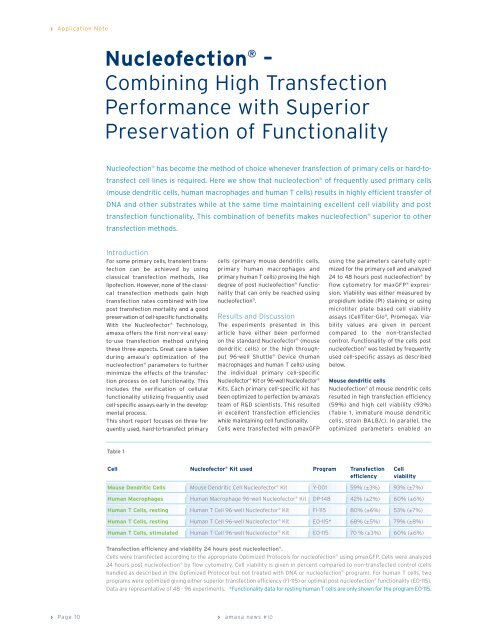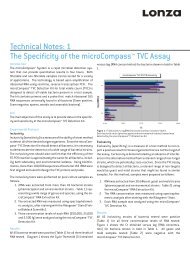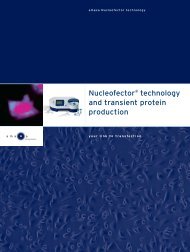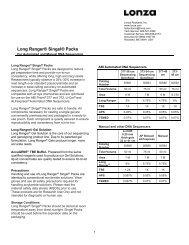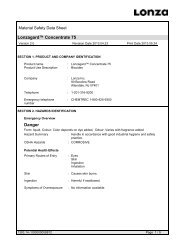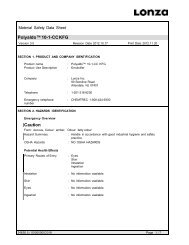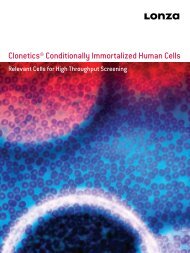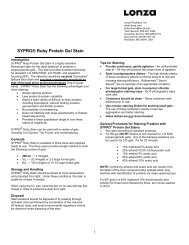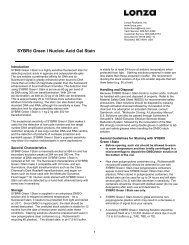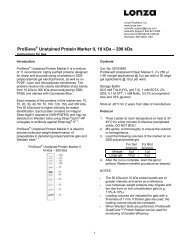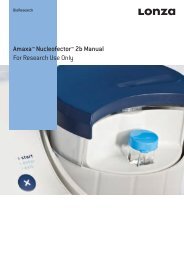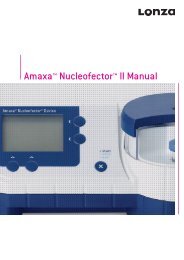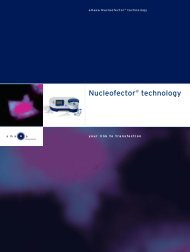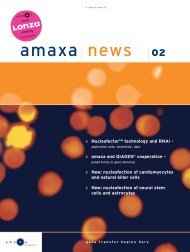amaxa news #10 - Lonza AG
amaxa news #10 - Lonza AG
amaxa news #10 - Lonza AG
You also want an ePaper? Increase the reach of your titles
YUMPU automatically turns print PDFs into web optimized ePapers that Google loves.
› Application Note<br />
Nucleofection ® –<br />
Combining High Transfection<br />
Performance with Superior<br />
Preservation of Functionality<br />
Nucleofection ® has become the method of choice whenever transfection of primary cells or hard-totransfect<br />
cell lines is required. Here we show that nucleofection ® of frequently used primary cells<br />
(mouse dendritic cells, human macrophages and human T cells) results in highly efficient transfer of<br />
DNA and other substrates while at the same time maintaining excellent cell viability and post<br />
transfection functionality. This combination of benefits makes nucleofection ® superior to other<br />
transfection methods.<br />
Introduction<br />
For some primary cells, transient transfection<br />
can be achieved by using<br />
classical transfection methods, like<br />
lipofection. However, none of the classical<br />
transfection methods gain high<br />
transfection rates combined with low<br />
post transfection mortality and a good<br />
preservation of cell-specific functionality.<br />
With the Nucleofector ® Technology,<br />
<strong>amaxa</strong> offers the first non-viral easyto-use<br />
transfection method unifying<br />
these three aspects. Great care is taken<br />
during <strong>amaxa</strong>’s optimization of the<br />
nucleofection ® parameters to further<br />
minimize the effects of the transfection<br />
process on cell functionality. This<br />
includes the verification of cellular<br />
functionality utilizing frequently used<br />
cell-specific assays early in the developmental<br />
process.<br />
This short report focuses on three frequently<br />
used, hard-to-transfect primary<br />
Table 1<br />
cells (primary mouse dendritic cells,<br />
primary human macrophages and<br />
primary human T cells) proving the high<br />
degree of post nucleofection ® functionality<br />
that can only be reached using<br />
nucleofection ® .<br />
Results and Discussion<br />
The experiments presented in this<br />
article have either been performed<br />
on the standard Nucleofector ® (mouse<br />
dendritic cells) or the high throughput<br />
96-well Shuttle ® Device (human<br />
macrophages and human T cells) using<br />
the individual primary cell-specific<br />
Nucleofector ® Kit or 96-well Nucleofector ®<br />
Kits. Each primary cell-specific kit has<br />
been optimized to perfection by <strong>amaxa</strong>’s<br />
team of R&D scientists. This resulted<br />
in excellent transfection efficiencies<br />
while maintaining cell functionality.<br />
Cells were transfected with pmaxGFP<br />
› Page 10 › <strong>amaxa</strong> <strong>news</strong> # 10<br />
using the parameters carefully optimized<br />
for the primary cell and analyzed<br />
24 to 48 hours post nucleofection ® by<br />
flow cytometry for maxGFP ® expression.<br />
Viability was either measured by<br />
propidium iodide (PI) staining or using<br />
microtiter plate based cell viability<br />
assays (CellTiter-Glo ® , Promega). Viability<br />
values are given in percent<br />
compared to the non-transfected<br />
control. Functionality of the cells post<br />
nucleofection ® was tested by frequently<br />
used cell-specific assays as described<br />
below.<br />
Mouse dendritic cells<br />
Nucleofection ® of mouse dendritic cells<br />
resulted in high transfection efficiency<br />
(59%) and high cell viability (93%)<br />
(Table 1, immature mouse dendritic<br />
cells, strain BALB/c). In parallel, the<br />
optimized parameters enabled an<br />
Cell Nucleofector ® Kit used Program Transfection Cell<br />
efficiency viability<br />
Mouse Dendritic Cells Mouse Dendritic Cell Nucleofector ® Kit Y-001 59% (±3%) 93% (±7%)<br />
Human Macrophages Human Macrophage 96-well Nucleofector ® Kit DP-148 42% (±2%) 60% (±6%)<br />
Human T Cells, resting Human T Cell 96-well Nucleofector ® Kit FI-115 80% (±6%) 53% (±7%)<br />
Human T Cells, resting Human T Cell 96-well Nucleofector ® Kit EO-115* 68% (±5%) 79% (±8%)<br />
Human T Cells, stimulated Human T Cell 96-well Nucleofector ® Kit EO-115 70 % (±3%) 60% (±6%)<br />
Transfection efficiency and viability 24 hours post nucleofection ® .<br />
Cells were transfected according to the appropriate Optimized Protocols for nucleofection ® using pmaxGFP. Cells were analyzed<br />
24 hours post nucleofection ® by flow cytometry. Cell viability is given in percent compared to non-transfected control (cells<br />
handled as described in the Optimized Protocol but not treated with DNA or nucleofection ® program). For human T cells, two<br />
programs were optimized giving either superior transfection efficiency (FI-115) or optimal post nucleofection ® functionality (EO-115).<br />
Data are representative of 48 - 96 experiments. *Functionality data for resting human T cells are only shown for the program EO-115.


